|
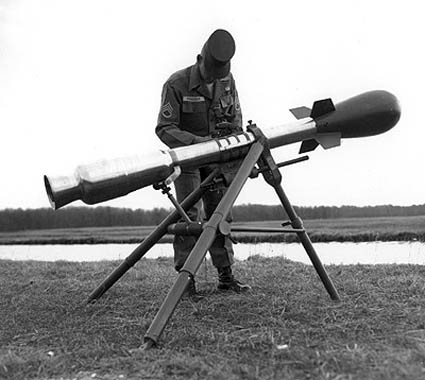
The Davy Crockett (shown here at the Aberdeen Proving Ground in Maryland in March 1961) was the smallest and lightest nuclear weapon ever deployed by the U.S. military. It was designed for use in Europe against Soviet troop formations.
The Davy Crockett consisted of an XM-388 projectile launched from either a 120-millimeter (XM-28) or 155-millimeter (XM-29) recoilless rifle (the 120 millimeter version is shown above). This weapon had a maximum range of 1.24 miles (120 millimeter) to 2.49 miles (155 millimeter). The XM-388 casing (including the warhead and fin assembly) weighed 76 pounds, was 30 inches long and measured 11 inches in diameter (at its widest point). The M29 155mm launcher is shown below.
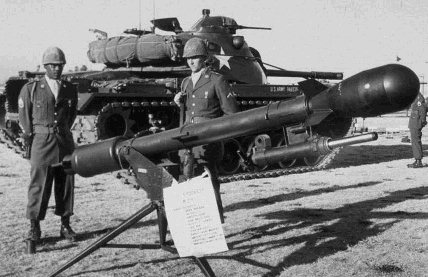
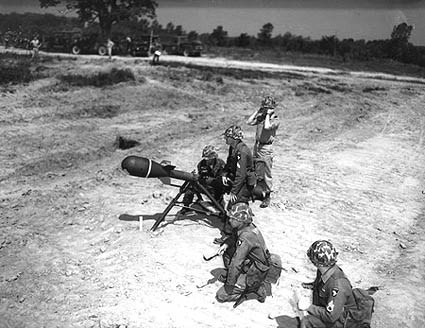
Infantry personnel of the 101st Airborne Division preparing to fire a Davy Crockett during a training exercise at Fort Campbell, Kentucky, May 14, 1962
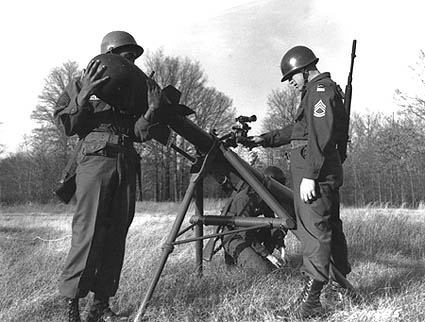
Soldiers conducting tests of the Davy Crockett at the Aberdeen Proving Ground, Maryland, December 16, 1959
The W54 warhead used on the Davy Crockett weighed just 51 pounds and was the smallest and lightest fission bomb (implosion type) ever deployed by the United States, with a variable explosive yield of 0.01 kilotons (equivalent to 10 tons of TNT, or two to four times as powerful as the ammonium nitrate bomb which destroyed the Alfred P. Murrah federal building in Oklahoma City on April 19, 1995), or 0.02 kilotons-1 kiloton. A 58.6 pound variant, the B54, was used in the Special Atomic Demolition Munition (SADM), a nuclear land mine deployed in Europe, South Korea, Guam, and the United States from 1964-1989.
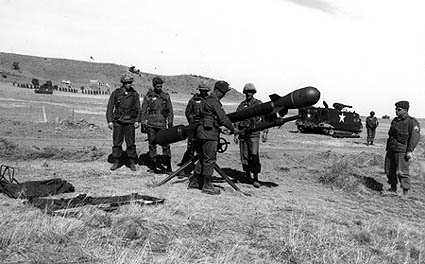
The crew of an XM-29 version of the Davy Crockett prepares it for a live fire demonstration at Fort Carson, Colorado, March 13, 1967. Here, the 37-millimeter spotting gun is being loaded (this gun is fired before the warhead to check the weapon's trajectory and make necessary adjustments).
The Davy Crockett was deployed with U.S. Army forces from 1961 to 1971. Between 1956 and 1963, 2,100 were produced at an estimated cost (excluding the warhead) of $540 million (in constant 1996 dollars). The weapon's non-nuclear components were manufactured at the Rock Island Arsenal in Rock Island, Illinois. The W54 warhead was designed at the Los Alamos Scientific Laboratory (now the Los Alamos National Laboratory) and built by the Atomic Energy Commission.
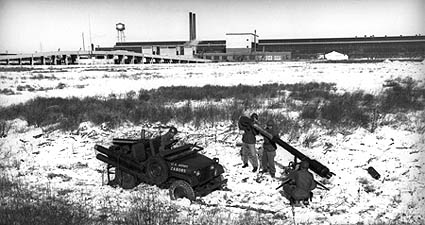
Soldiers at the Aberdeen Proving Ground, Maryland, demonstrate how to set up an XM-29 version of the Davy Crockett (1961).
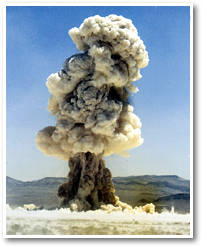 Stockpiled W54 warheads were test fired at the Nevada Test Site on July 7 and 17, 1962, during the Little Feller II and Little Feller I shots. In Little Feller II on July 7, the warhead was suspended on cables about three feet above the ground (yield was 22 tons). In Little Feller I on July 17, a Davy Crockett was fired from a stationary 155 millimeter launcher (in tandem with simulated battlefield manuevers under Operation IVY FLATS) and detonated about 20 feet above the ground at a distance of 9,357 feet (1.7 miles) from the launch point (yield was 18 tons). This test, the last atmospheric detonation at the Nevada Test Site, was observed by Attorney General Robert F. Kennedy and presidential adviser General Maxwell D. Taylor. Footage of Operation IVY FLATS was declassified by the Department of Energy on December 22, 1997. The plutonium warhead's diameter was just short of 11 inches, was over 15 inches long, and weighed 50 pounds. The explosive yield in this test was equal to 22 tons of TNT. Stockpiled W54 warheads were test fired at the Nevada Test Site on July 7 and 17, 1962, during the Little Feller II and Little Feller I shots. In Little Feller II on July 7, the warhead was suspended on cables about three feet above the ground (yield was 22 tons). In Little Feller I on July 17, a Davy Crockett was fired from a stationary 155 millimeter launcher (in tandem with simulated battlefield manuevers under Operation IVY FLATS) and detonated about 20 feet above the ground at a distance of 9,357 feet (1.7 miles) from the launch point (yield was 18 tons). This test, the last atmospheric detonation at the Nevada Test Site, was observed by Attorney General Robert F. Kennedy and presidential adviser General Maxwell D. Taylor. Footage of Operation IVY FLATS was declassified by the Department of Energy on December 22, 1997. The plutonium warhead's diameter was just short of 11 inches, was over 15 inches long, and weighed 50 pounds. The explosive yield in this test was equal to 22 tons of TNT.
Above is a photograph of the code named "SMALL BOY" test shot (LITTLE FELLER I) - the second Davy Crockett detonation. Historical records don't state why LITTLE FELLER II occurred before LITTLE FELLER I.
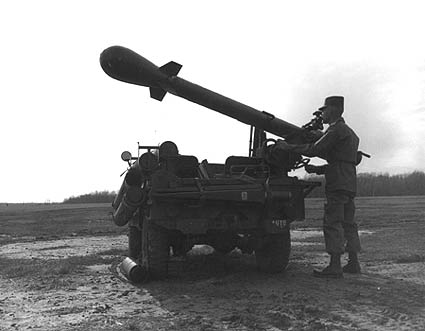
The Davy Crockett could also be launched from specially equipped jeeps.
Sources: U.S. Nuclear Weapons Cost Study Project; Thomas B. Cochran, William M. Arkin, Milton M. Hoenig, U.S. Nuclear Forces and Capabilities, Volume I, Nuclear Weapons Databook (Cambridge, Massachusetts: Ballinger Publishing Company, 1984), pp. 60, 311; Robert Standish Norris and Thomas B. Cochran, "United States Nuclear Tests: July 1945 to 31 December 1992," (Washington, D.C.: Natural Resources Defense Council, 1 February 1994), NWD-94-1, p. 35; Chuck Hansen, U.S. Nuclear Weapons: The Secret History (New York: Orion Books, 1988), pp. 197-198; Ted Nicholas and Rita Rossi, U.S. Historical Military Aircraft and Missile Data Book (Fountain Valley, California: Data Search Associates, 1991), pp. 3-95, 3-101; U.S. Department of Energy.
Credit: National Archives |